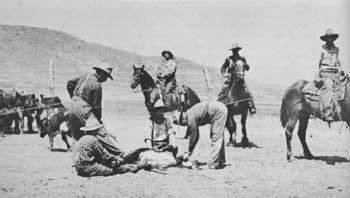






Historical Background
End of the Open Range Cattle Era
The movement of homesteaders, or nesters, into the Great Plains and Rocky Mountain States had started at approximately the same time as that of the cattlemen. Almost unnoticed at first, the nesters soon offered a formidable challenge to the cattle kings and eventually triumphed over them. Increasing steadily in numbers, they closed in around the large spreads, staked claims to prime grass and water, and established farms or small ranches. Finding a place along a stream where the cattleman had been unable to preempt every bit of adjacent land, a farmer would stake his claim and dig an irrigation ditch to supply his fields. A second farmer would homestead at the rear of the first, and the ditch would be extended to the second farm—and so the farms multiplied. Farmers shot trespassing cattle and drew upon the herds for their beef supply; they called such meat "slow elk." Then they began to fence the open range.
BARBED WIRE AND "WARS"
For years an answer to the need for a cheap fencing material for the open West had been sought. Farmers at first had planted the thorny Osage-orange and black locust, hedges that were drought resistant and reasonably stock-proof. Then in 1873 Jacob F. Glidden, a De Kalb, Ill., farmer, invented barbed wire. Slow to sell at first, the new two-strand wire gradually found a market when it was proven that cattle actually were kept in—or out—by it. Homesteaders began fencing their acres and small ranchers their grass, and the proponents of the open range were brought face-to-face with their greatest challenge.
The first lands to be fenced were those with a supply of water. The owner naturally kept out those animals that did not belong to him and pushed them back on the overcrowded open range. Once fencing got underway on a wide scale, the large ranchers had to make a choice: they could join the movement, or they could fight it. To do nothing would bring ruin.
By 1883 fence-cutting "wars" were widespread. In Texas, for example, in more than half the 171 organized counties fence cutting assumed epidemic proportions. In some counties the proponents and opponents of barbed wire were so evenly divided that civil war seemed imminent. Gov. John Ireland was forced to call out the Rangers and invoke a special session of the legislature to consider the problem. The legislature made fence cutting a felony and ruled that the enclosing of any land not owned or leased was illegal. Finally, public opinion swung against the fence cutters, and the "war" drew to a close.
 |
| Working the roundup. Cutting out cattle without unduly disturbing the herd required great proficiency on the part of the rider as well as his horse. Photograph by Erwin E. Smith. (Courtesy, Mrs. L. M. Pettis and the Library of Congress.) |
The Texas experience was repeated elsewhere, until the cattle kings were forced to join in the enclosure movement. Other factors hastening the spread of fencing—and the end of the open range era—were the extension of the railroads, the discovery of more adequate ground water, and the use of windmills to obtain it. The large cattle companies, most of them owned by Eastern capitalists, led in the fencing movement, and gradually the lesser cattle kings followed suit.
STOCKMEN'S PROTECTIVE ASSOCIATIONS
To protect themselves from the homesteaders—and from cattle rustlers among their own ranks—the fiercely individualistic cattlemen succumbed to necessity and formed protective stockmen's associations. Few other frontier organizations ever achieved the power and efficiency of these associations. They employed a large force of range detectives to keep an alert eye on everyone and everything in the cattle business. They organized and supervised roundups, administered grass and water rights, and investigated cattle diseases. And they exerted strong influence on State and Territorial legislatures to assure laws favorable to the welfare of the large cattlemen. By 1885 they blanketed the Great Plains and Rocky Mountain States.
The strength and efficiency of the stockmen's associations ultimately resulted in the development of a violent antagonism on the part of the townsmen and small ranchers, who joined the farmers in fighting the associations. In time even the brazen larcenies of cattle rustlers went unpunished because grand juries in the towns would not indict anyone harassing the large ranchers.
Against this rising tide of popular sentiment the Wyoming Stock Growers Association, the most influential and successful of the cattlemen's groups, made a last desperate bid to regain its authority. In the Johnson County War of 1892, it used imported gunmen to eliminate opposition. Public opinion was inflamed against the members of the association, and for a time it seemed likely that every head of stock owned by the large companies in Wyoming would be slaughtered. The Johnson County War and its disastrous outcome demonstrated to cattlemen that range wars were not the solution to their problems.
OVEREXPANSION
The closing of the cattlemen's frontier was finally brought about, not by barbed wire or by homesteaders, but by overexpansion and nature. Until about 1885 most of the larger outfits were returning at least a paper profit despite the crowding of herd upon herd, absentee and often inefficient management, and wholesale thievery. That year the arrival of 200,000 cattle from the Indian Territory, removed from the Cheyenne-Arapaho Reservation by proclamation of President Cleveland, smothered the already crowded ranges of Kansas, Colorado, and the Texas Panhandle.
The year 1886 was one of crisis. Ranchers in the Southwest, who had suffered heavy losses the preceding winter, unloaded what was left of their herds on the falling market. The editor of the Rocky Mountain Husbandman, noting that the market was growing weaker by the day, advised that "it would be better to sell at a low figure than to endanger the whole herd by having the range overcrowded." The summer of 1886 was hot and dry. The grass withered and streams disappeared. Cattle were in exceptionally poor condition for the coming winter. Some ranchers forestalled disaster by driving their herds across the Canadian border and leasing new grazing lands. Others shipped cattle to Iowa and Nebraska for fattening.
 |
| Branding scene. After the ropers and heelers got the calf in position, the brander applied the iron and another puncher slit the ears for further identification. Despite Hollywood prototypes, these cowboys seemed to find suspenders more helpful to their work than sixguns. (Courtesy, National Archives.) |
THE WINTER OF 1886-87
Then came the catastrophic winter of 1886-87, probably the most severe ever experienced on the Plains. The storms came early. A chinook that blew up from the south in January, melting snow and bringing hope, was immediately followed by a howling blizzard. Cattle, driven by a merciless wind, piled up against fences and died by the thousands. A numbing cold followed the storm, and the thermometer dropped out of sight. Cowboys, imprisoned for weeks around bunkhouse stoves, dared not think of the starving, freezing herds, helpless to find food or shelter.
When spring finally came, cattlemen saw a sight that they spent the rest of their lives trying to forget: Carcass piled upon carcass, gaunt cattle staggering about on frozen feet, and trees stripped bare of their bark. Perhaps the most expressive description of the catastrophe is artist Charlie Russell's celebrated painting "The Last of the 5,000," which shows a single, starving cow in deep snow, a hungry coyote waiting nearby. Rancher Granville Stuart said that the cattle business, which "had been fascinating to me before, suddenly became distasteful," and estimated his loss at 66 percent of his herd. Most stockmen had severe losses; many were wiped out.
The range was still as good as ever, and stood an excellent chance of recovering from the overgrazing. But cattlemen had lost their confidence—the unshakable optimism that had lured them into taking chances in the expectation of wealth. Outside capital, freely supplied in the days of easy profits, low operating costs, and rapidly expanding herds, was no longer available. Those cattlemen who remained in business did so by developing new methods. All realized that they had been mistaken in believing that the grass of the open range was sufficient to build a lasting empire.
That disastrous winter had another far-reaching effect. Bankruptcy broke up many of the great corporate ranches and to a large extent ended the period of absentee ownership. The Swan Land and Cattle Company, largest of all the companies on the northern range, went into receivership in May 1887. Many of the small ranchers and a few of the larger pioneer ranchers remained, and some of them purchased the stock and land of the large companies that went bankrupt. Even so enthusiastic a cattleman as Theodore Roosevelt, whose own herds on the Little Missouri had been decimated, believed it "right and necessary" that the era of the open range should pass, and that the future of the country should lie with the small agriculturist—be he farmer or rancher.
And that fateful winter brought an end to the romantic era of the great trail drives. Farmers fenced in the trail and plowed it under. The open range cattle era had faded into the mists of history.
 |
 |
http://www.cr.nps.gov/history/online_books/prospector-cowhand-sodbuster/intro7.htm
Last Updated: 22-May-2005